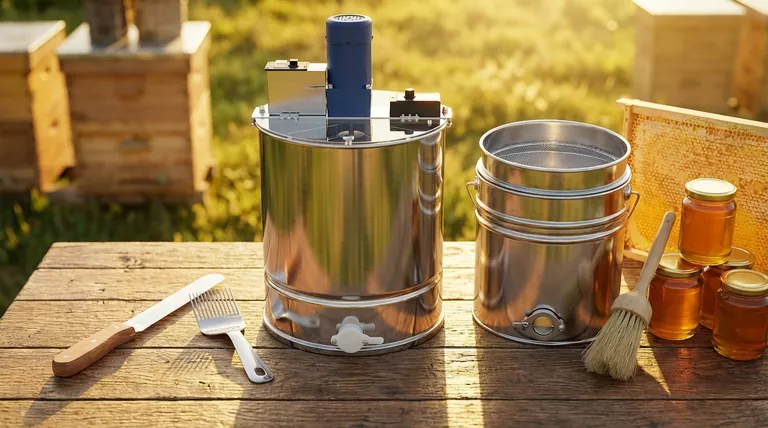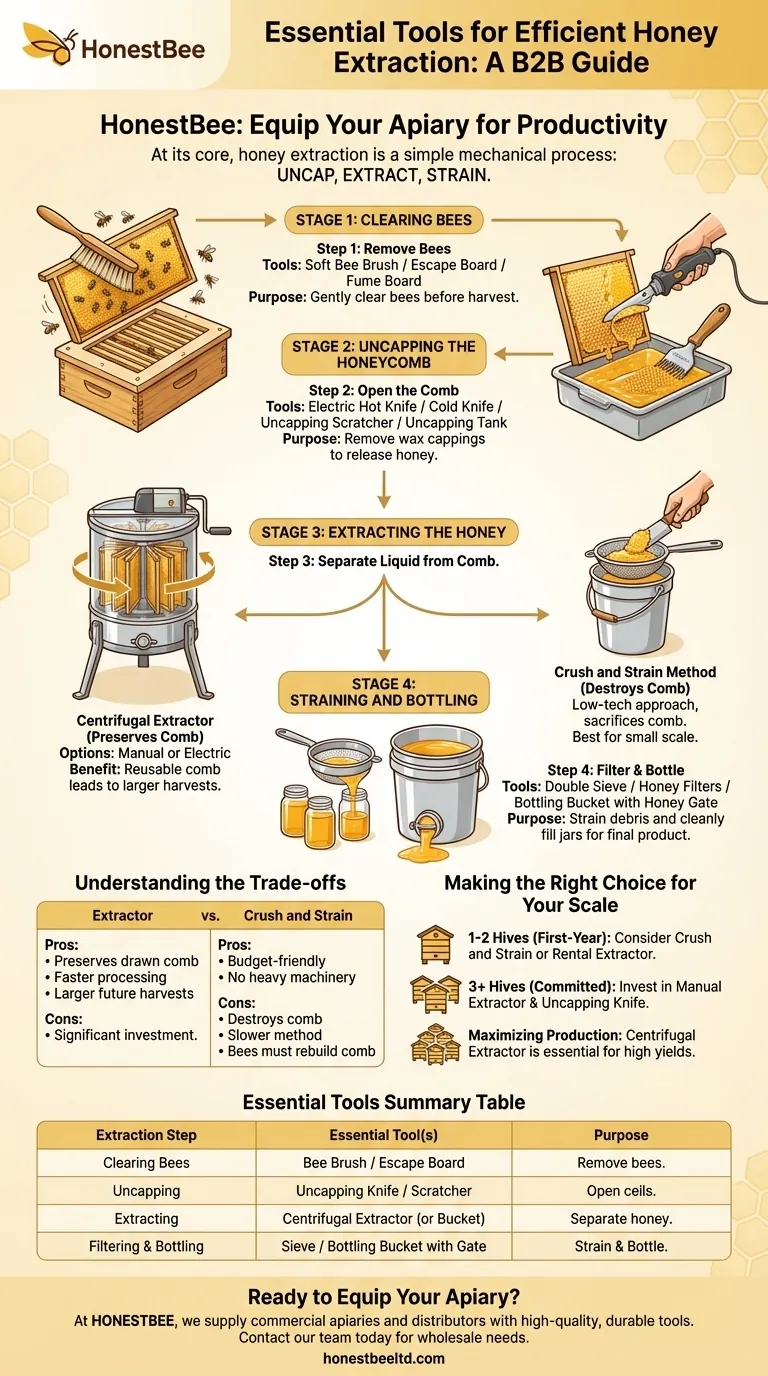At its core, honey extraction requires just three types of tools. You need a way to open the sealed honeycomb, a method to get the honey out of the comb, and a system to filter and bottle the final product. The essential tools are an uncapping knife or scratcher, a honey extractor (or a simple bucket for the crush-and-strain method), and a bucket with a filter and a spigot, often called a honey gate.
While the market offers a vast array of specialized equipment, a successful honey harvest boils down to a simple, three-step mechanical process: uncap, extract, and strain. Understanding this workflow is the key to choosing only the tools you truly need.

The Honey Extraction Workflow: A Tool-by-Tool Guide
To make a smart investment, it's best to think about the tools in the context of the job they perform. The entire process can be broken down into four distinct steps.
Step 1: Clearing Bees from the Frames
Before you can bring your honey frames indoors, you must remove the bees.
A soft bee brush is the most direct tool. You gently brush the bees off the comb surface, frame by frame, right at the hive entrance. For a more passive approach, an escape board or fume board can be placed on the hive a day or hours before, which encourages bees to leave the honey supers without you needing to brush them off.
Step 2: Uncapping the Honeycomb
Bees seal their finished honey in cells with a layer of beeswax, called cappings. You must remove this layer to release the honey.
Your primary tool here is an uncapping knife. A simple cold knife, which you dip in hot water, works well but is slower. An electric hot knife maintains a constant temperature, allowing you to slice off the cappings more quickly and cleanly.
For any low spots or areas the knife misses, an uncapping scratcher (also called a cappings fork) is essential for pricking open the remaining sealed cells. The removed cappings, which are full of honey, should be collected in an uncapping tank or a simple food-grade bucket.
Step 3: Extracting the Honey
This is where you separate the liquid honey from the beeswax comb. You have two primary methods, each with its own set of tools.
The most common method uses a centrifugal honey extractor. This machine spins the frames, using centrifugal force to sling the honey out against the drum wall without destroying the comb. Extractors can be manual (hand-crank) or electric, and they come in various sizes.
The alternative is the crush and strain method. This low-tech approach involves scraping the entire honeycomb off its foundation into a bucket and mashing it up to release the honey. This method does not require an extractor but sacrifices the beeswax comb.
Step 4: Straining and Bottling
The raw honey from the extractor or crushing process will contain particles of beeswax and other debris.
A double sieve or a set of honey filters is used to strain the honey, ensuring a clean final product. These typically consist of a coarse filter to catch large wax pieces and a fine filter to remove smaller particles. Many beekeepers simply use cheesecloth as a low-cost option.
Finally, the filtered honey is poured into a bottling bucket. This is a food-grade pail fitted with a honey gate—a special spigot at the bottom that allows you to easily and cleanly fill jars without making a mess.
Understanding the Trade-offs: Extractor vs. Crush and Strain
For a new beekeeper, the most significant decision is whether to invest in an extractor. The choice has major implications for cost and efficiency.
The Case for a Honey Extractor
An extractor is a significant investment, but it preserves the most valuable resource in the hive: drawn-out comb. Bees expend enormous energy to build this comb, and by returning it to them empty, you give them a massive head start on the next honey flow. This almost always results in a larger honey harvest the following year.
The Case for Crush and Strain
The crush and strain method is the most budget-friendly entry into honey harvesting. It requires no specialized machinery beyond buckets and filters. However, this method destroys the comb, forcing the bees to rebuild it from scratch, which consumes time and resources (nectar) that could have otherwise been used to make more honey.
Making the Right Choice for Your Scale
Your decision should be based on your budget, the number of hives you manage, and your long-term beekeeping goals.
- If you are a first-year beekeeper with 1-2 hives: Consider the crush and strain method or find a local beekeeping club that rents extractors. This minimizes your upfront cost while you learn.
- If you are committed to beekeeping with 3+ hives: Investing in a small manual extractor and a good uncapping knife is a practical choice that will dramatically increase your efficiency and honey yield over time.
- If your primary focus is maximizing honey production: A centrifugal extractor is the only option, as preserving your drawn comb is the single biggest factor in achieving high yields.
Ultimately, you can start simply with the bare essentials and scale your equipment as your apiary and experience grow.
Summary Table:
| Extraction Step | Essential Tool(s) | Purpose |
|---|---|---|
| Clearing Bees | Bee Brush / Escape Board | Remove bees from honey frames before harvest. |
| Uncapping | Uncapping Knife / Scratcher | Slice off wax cappings to open honeycomb cells. |
| Extracting | Centrifugal Extractor (or Bucket) | Separate honey from comb, preserving wax. |
| Filtering & Bottling | Sieve/Filter & Bottling Bucket with Honey Gate | Strain debris and cleanly fill jars. |
Ready to equip your apiary for a more efficient and productive harvest?
At HONESTBEE, we supply commercial apiaries and beekeeping equipment distributors with the high-quality, durable tools mentioned in this guide. From manual and electric extractors to uncapping tanks and honey gates, our wholesale-focused operations ensure you get the reliable equipment you need to maximize your honey yield.
Contact our team today to discuss your specific needs and get a quote on our full range of beekeeping supplies.
Visual Guide

Related Products
- electric honey extractor honey centrifuge 3 frame honey extractor stainless steel honey frame extractor
- 8-Frame Electric Self-Reversing Honey Extractor Spinner for Commercial Honey Extraction Equipment
- Electric 8 Frame Honey Spinner Extractor Equipment for Beekeeping
- 40 Frame Commercial Electric Honey Extractor for Beekeeping
- 2 Frame Stainless Steel Manual Honey Spinner Extractor for Beekeeping
People Also Ask
- What is needed for honey extraction? A Complete Guide to Essential Tools & Methods
- What is the basic principle of the honey extractor? Harness Centrifugal Force for Efficient Harvesting
- What are the steps for honey extraction using a centrifuge? A Guide to Efficient, Comb-Preserving Harvests
- How long does honey take to extract? A Guide to Streamlining Your Harvest Process
- How does an electric honey extractor work? Automate Your Harvest for Maximum Efficiency



















